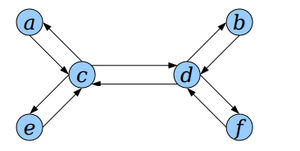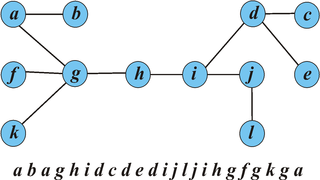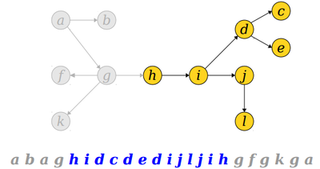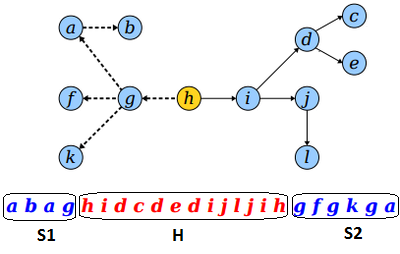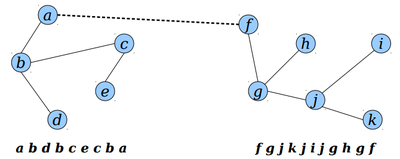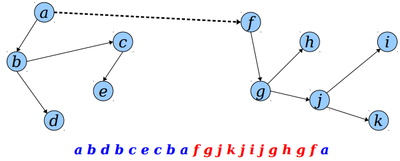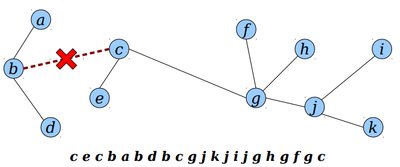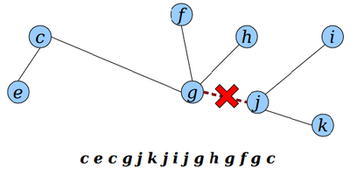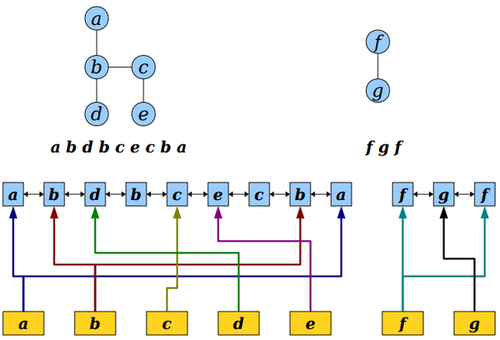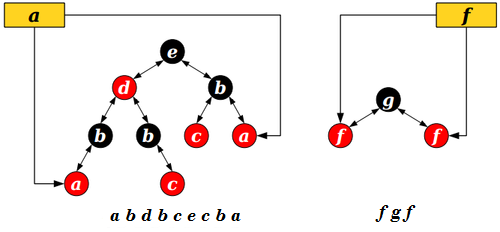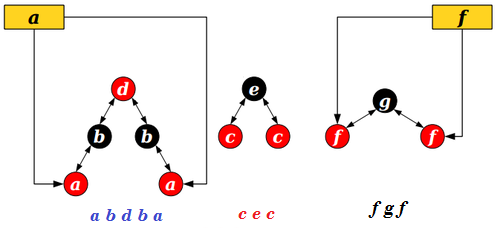Деревья Эйлерова обхода
Введение
Динамические деревья (англ.dynamic tree) используются в двух областях:.........
Нужно поддерживать следующие операции
- — добавить ребро (u, w) (при условии, что вершины u w принадлежат разным деревьям)
- — разрезать ребро (u, w) (при условии, что ребро (u, w) принадлежит дереву),
- — принадлежат ли вершины u и w одной компоненте связности.
Euler tour tree - The data structure we'll develop can perform these operations time O(log n) each.
Представление деревьев в виде их эйлерова обхода
В основном, деревья не являются эйлеровыми графами.
Technique: replace each edge {u, v} with two edges (u, v) and (v, u).
Resulting graph has an Euler tour.
High-level idea: Instead of storing the trees in the forest, store their Euler tours.
Each edge insertion or deletion translates into a set of manipulations on the Euler tours of the trees in the forest.
Checking whether two nodes are connected can be done by checking if they're in the same Euler tour.
Properties of Euler Tours
The sequence of nodes visited in an Euler tour of a tree is closely connected to the structure of the tree.
Begin by directing all edges toward the the first node in the tour.
Claim: The sequences of nodes visited between the first and last instance of a node v gives an Euler tour of the subtree rooted at v.
Операции
Rerooting a Tour
The subtrees defined by ranges in Euler tours on trees depend on the root.
In some cases, we will need to change the root of the tree.
Algorithm:
Split the tour into three parts: S₁, R, and S₂, where R consists of the nodes between the first and last occurrence of the new root r.
Delete the first node in S₁.
Concatenate R, S₂, S₁, {r}.
link(u ,v)
Given two trees T₁ and T₂, where u ∈ T₁ and v ∈ T₂, executing link(u, v) links the trees together by adding edge {u, v}.
Watch what happens to the Euler tours:
To link T₁ and T₂ by adding {u, v}:
Let E₁ and E₂ be Euler tours of T₁ and T₂, respectively.
Rotate E₁ to root the tour at u.
Rotate E₂ to root the tour at v.
Concatenate E₁, E₂, {u}.
cut(u ,v)
Given a tree T, executing cut(u, v) cuts the edge {u, v} from the tree (assuming it exists).
Watch what happens to the Euler tour of T:
To cut T into T₁ and T₂ by cutting {u, v}:
Let E be an Euler tour for T.
Rotate u to the front of E.
Split E into E₁, V, E₂, where V is the span between the first and last occurrence of v.
T₁ has the Euler tour formed by concatenating E₁ and E₂, deleting the extra u at the join point.
T₂ has Euler tour V.
Реализация структуры
Goal: Implement link, cut, and is-connected as efficiently as possible.
By representing trees via their Euler tours, can implement link and cut so that only O(1) joins and splits are necessary per operation.
Questions to answer:
How do we efficiently implement these joins and splits?
Once we have the tours, how do we answer connectivity queries?
Implementing the Structure
The operations we have seen require us to be able to efficiently do the following:
Identify the first and last copy of a node in a sequence.
Split a sequence at those positions.
Concatenate sequences.
Add a new copy of a node to a sequence.
Delete a duplicate copy of a node from a sequence.
How do we do this efficiently?
Linked Lists
Each split or concatenate takes time O(1).
The first and last copy of a node can be identified in time O(1).
A new copy of a node can be appended to the end of the sequence in time O(1).
A redundant copy of a node can be deleted in time O(1).
Everything sounds great!
Question: How do you test for connectivity?
Euler tours give a simple, flexible encoding of tree structures.
Using doubly-linked lists, concatenation and splits take time O(1) each, but testing connectivity takes time Θ(n) in the worst-case.
Can we do better?
Balanced Trees
Claim: It is possible to represent sequences of elements balanced binary trees.
These are not binary search trees. We're using the shape of a red/black tree to ensure balance.
Observation 1: Can still store pointers to the first and last occurrence of each tree node.
Observation 2: If nodes store pointers to their parents, can answer is-connected(u, v) in time O(log n) by seeing if u and v are in the same tree.
Observation 3: Red/black trees can be split and joined in time O(log n) each.
The data structure:
Represent each tree as an Euler tour.
Store those sequences as balanced binary trees.
Each node in the original forest stores a pointer to its first and last occurrence.
Each node in the balanced trees stores a pointer to its parent.
link, cut, and is-connected queries take time only O(log n) each.
Сравнительная табличка
Похожие структуры
Про link-cut trees
